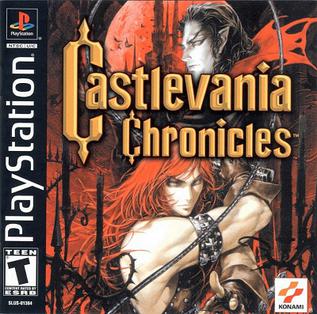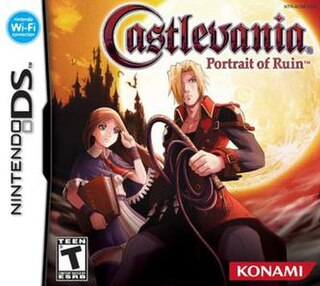
Castlevania, known in Japan as Akumajō Dracula, is a gothic horror action-adventure video game series and media franchise about Dracula, created and developed by Konami. It has been released on various platforms, from early systems to modern consoles, as well as handheld devices such as mobile phones. The franchise has expanded into several spin-off video games and other media, including comic books and an animated television series.

Castlevania: Rondo of Blood, originally released in Japan as Akumajō Dracula X: Chi no Rondo, is a 1993 platform game developed by Konami for the PC Engine's Super CD-ROM² System directed by Toru Hagihara. Part of the Castlevania series, protagonist Richter Belmont goes to save his lover Annette, who was abducted by Dracula. It was first released exclusively in Japan on October 29, 1993. A direct sequel, Castlevania: Symphony of the Night, was released worldwide in 1997.

Multi-memory controllers or memory management controllers (MMC) are different kinds of special chips designed by various video game developers for use in Nintendo Entertainment System (NES) cartridges. These chips extend the capabilities of the original console and make it possible to create NES games with features the original console cannot offer alone. The basic NES hardware supports only 40KB of ROM total, up to 32KB PRG and 8KB CHR, thus only a single tile and sprite table are possible. This limit was rapidly reached within the Famicom's first two years on the market and game developers began requesting a way to expand the console's capabilities.

Castlevania III: Dracula's Curse is a 1989 platform game developed and published by Konami for the Nintendo Entertainment System. It was released in Japan in 1989, and in North America in 1990, and in Europe by Palcom in 1992. It was later released on the Virtual Console for the Wii, Nintendo 3DS, and Wii U.

Castlevania: Curse of Darkness is a 2005 action-adventure game developed and published by Konami. It is the fourth 3D Castlevania title, following Castlevania: Lament of Innocence, and was released for PlayStation 2 and Xbox in all regions except Japan, where the game was only available on PlayStation 2. Curse of Darkness received mixed reviews, common praise was directed towards its combat system, music, content, and replay value, while criticism fell towards its story, characters, repetitive level-design and gameplay.

Castlevania, also referred to as Castlevania 64, is a 1999 action-adventure game developed by Konami's Kobe branch for the Nintendo 64. An expanded version of the game, Castlevania: Legacy of Darkness, was released later in the same year.

Castlevania: Legacy of Darkness is a 1999 action-adventure game developed and published by Konami for the Nintendo 64. A prequel and expanded version of Castlevania, also released on the Nintendo 64 earlier the same year, it contains a remake of the original game with improved graphics, added villains, and alternate versions of some levels.

Castlevania Legends is a 1997 platform game developed and released by Konami for the Game Boy. The third Castlevania game released for the system, the story follows Sonia Belmont, a vampire hunter battling the first incarnation of Count Dracula. The game was conceived as a prequel to all other games in the Castlevania series; however, it later became recognized as non-canon.

Super Castlevania IV is a 1991 platform game developed and published by Konami for the Super Nintendo Entertainment System. It has been re-released multiple times, including for the Super NES Classic Edition.

Castlevania: Dracula X, titled Castlevania: Vampire's Kiss in Europe, is a 1995 platform game developed and published by Konami for the Super Nintendo Entertainment System. It is the second Castlevania installment to be released for the Super NES. It is a remake of Castlevania: Rondo of Blood, which was previously released in Japan on the PC Engine Super CD-ROM2 in 1993. While the plot is similar to Rondo of Blood and it uses many of that game's graphics, it features new levels and altered gameplay elements, rather than being a direct port because of the limits of the Super NES cartridge format and exclusivity agreements with PC Engine maker NEC. It was released on July 21, 1995 in Japan, in September 1995 in North America, February 22, 1996 in Europe, and on June 22, 1996, in Australia. The game received mixed reviews, with journalists considering it inferior to Rondo of Blood and criticizing its high difficulty.

Haunted Castle is a 1987 platform game developed and released by Konami for arcades. It is the second arcade game in the Castlevania franchise, following Vs. Castlevania, an arcade port of the original 1986 NES video game released in North America. Unlike the previous arcade title in the franchise, Haunted Castle is not a direct port of an existing console game, but a newly-developed arcade game running on custom JAMMA-based board.

Castlevania Chronicles is a platform game compilation developed by Konami Computer Entertainment Tokyo for the PlayStation. It consists of two game modes: Original Mode, which is a port of the 1993 platform video game Akumajō Dracula for the X68000 home computer, and Arrange Mode, a modernized remake featuring a new introductory cinematic, new sprites, and re-balanced gameplay among other adjustments. The X68000 version of Akumajō Dracula is, itself, an updated remake of the original Castlevania for the NES, where the vampire hunter Simon Belmont must defeat Dracula and save Transylvania. The compilation was later released for the American and Japanese PlayStation Network as a PSone Classic in December 2008.

Castlevania: Portrait of Ruin is a 2006 action role-playing game developed and published by Konami. The game was released on November 16, 2006 in Japan, and in North America on December 5, 2006 for the Nintendo DS handheld game console. Portrait of Ruin is the first Castlevania to feature a cooperative multiplayer gameplay mode and the first handheld Castlevania to have English voice-overs, outside of its original Japanese release.

Castlevania: Order of Ecclesia is a 2008 action role-playing game and the third Nintendo DS installment of the Castlevania franchise. It was directed by Akihiro Minakata, with producer Koji Igarashi returning. The plot involves Shanoa, who is part of an organization set to defeat Dracula after the Belmont clan has vanished.

Castlevania Judgment is a 3D fighting video game developed by Eighting and published by Konami for the Wii. The game is based on the Castlevania series of games, and is the series' first fighting game.

Castlevania, known in Japan as Akumajō Dracula, is a 1986 platform game developed and published by Konami for the Family Computer Disk System. It was originally released in Japan in September 1986, before being ported to cartridge format and released in North America for the Nintendo Entertainment System (NES) in May 1987 and in Europe in 1988. It was also re-issued for the Family Computer in cartridge format in 1993. It is the first game in Konami's Castlevania video game series.

Akumajō Special: Boku Dracula-kun is a platform video game released by Konami in Japan for the Famicom on October 19, 1990. It is considered a parody of the Castlevania series. A version for mobile phones was released on 30 June 2006 in Japan.

Simon Belmont is a fictional character who serves as the first protagonist to appear in the Castlevania series. He appears in Castlevania, Vampire Killer, Haunted Castle, Castlevania II: Simon's Quest, Super Castlevania IV, and Castlevania Chronicles, and acts as a supporting character in Castlevania Judgment and Castlevania: Harmony of Despair. He also appeared as a playable character in DreamMix TV World Fighters and Super Smash Bros. Ultimate. Simon has received positive reviews from critics.




















